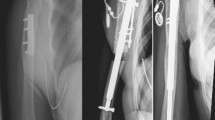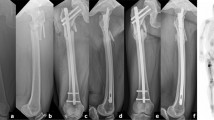Abstract
Purpose
Nonunion of the femur with significant shortening with retained intramedullary nail (IMN) is a challenging orthopedic problem. We investigated whether the application of Ilizarov distraction osteogenesis over the preexisting nail can simultaneously achieve union and correct shortening.
Methods
Thirteen patients with femoral diaphyseal nonunion associated with significant shortening with retained IMN were retrospectively reviewed. All patients were treated by distraction osteogenesis using a circular external fixator over the preexisting nail. The fixator was used to compress or distract the nonunion site and to gradually distract a separate osteotomy to restore limb length. The osteotomy was done percutaneously using the Gigli saw with the nail in situ. The applied surgical technique was bifocal compression distraction in 11 cases, bifocal distraction in one case, and monofocal distraction in one case.
Results
Bone healing was achieved in 11 cases (84.6 %) at both the nonunion and the lengthening sites. The mean length gained was 4 cm (range, 3–6 cm). The mean time to fracture union was 4.9 months (range, 4–6 months). The mean knee flexion improved from 86.5° (range, 40°–135°) preoperatively to 109.6° (range, 60°–125°) at final follow-up (p < 0.05). The mean limb-length discrepancy improved from 4.7 cm (range, 3–7.5) preoperatively to 0.7 cm (range, 0–3) at final follow-up (p < 0.001). Ten out of 13 patients had a total of 14 complications, with a mean of 1.1 complications per patient.
Conclusions
Distraction osteogenesis over the preexisting nail can be a good alternative to treat difficult femoral diaphyseal nonunions associated with significant shortening.




Similar content being viewed by others
References
Finkemeier CG, Chapman MW (2002) Treatment of femoral diaphyseal nonunions. Clin Orthop Relat Res 398:223–234
Babhutkar S, Pande K (2005) Nonunion of the diaphysis of long bones. Clin Orthop Relat Res 431:50–56
Johnson EE (1994) Acute lengthening of shortened lower extremities after malunion or non-union of a fracture. J Bone Joint Surg 76A:379–389
Bellabarba C, Ricci WM, Bolhofner BR (2001) Results of indirect reduction and plating of femoral shaft nonunions after intramedullary nailing. J Orthop Trauma 15:254–263
Hak DJ, Lee SS, Goulet JA (2000) Success of exchange reamed intramedullary nailing for femoral shaft nonunion or delayed union. J Orthop Trauma 14:178–182
Ueng SW, Chao EK, Lee SS et al (1997) Augmentative plate fixation for the management of femoral nonunion after intramedullary nailing. J Trauma 43:640–644
Menon DK, Dougall TW, Pool RD et al (2002) Augmentative Ilizarov external fixation after failure of diaphyseal union with intramedullary nailing. J Orthop Trauma 16:491–497
Brinker MR, O’Connor DP (2003) Ilizarov compression over a nail for aseptic femoral nonunions that have failed exchange nailing: a report of five cases. J Orthop Trauma 17(10):668–676
Inan M, Karaogtu S, Cirri F et al (2005) Treatment of femoral nonunions by using cyclic compression and distraction. Clin Orthop Retat Res 436:222-B
Paley D, Herzenberg JE, Paremain G et al (1997) Femoral lengthening over an intramedullary nail. J Bone Joint Surg Am 79:1464–1480
Paley D (1990) Problems, obstacles and complications of limb lengthening by the Ilizarov technique. Clin Orthop 250:81–104
Smith WR, Morgan SJ (2002) Failure of internal fixation of the femoral shaft. Tech Orthop 17:448–457
Choi YS, Kim KS (2005) Plate augmentation leaving the nail in situ and bone grafting for non-union of femoral shaft fractures. Int Orthop 29:287–290
Azzam W, Atef A (2015) Our experience in the management of segmental bone defects caused by gunshots. Int Orthop. doi:10.1007/s00264-015-2870-z. [Epub ahead of print]
Paley D (2003) Hardware and osteotomy considerations. In: Paley D, Herzenberg JE (eds) Principles of deformity correction. Springer, Berlin, pp 291–410
Catagni MA, Guerreschi F, Holman JA, Cattaneo R (1994) Distraction osteogenesis in the treatment of stiff hypertrophic nonunions using the Ilizarov apparatus. Clin Orthop 301:159–163
Ilizarov GA (1992) Transosseous osteosynthesis. Theoretical and clinical aspects of the regeneration and growth of tissue. Springer, Berlin
Aronson J (1997) Limb lengthening, skeletal reconstruction and bone transport with the Ilizarov method. J Bone Joint Surg Am 79:1243–1258
Song HR, Cho SH, Koo KH et al (1998) Tibial bone defects treated by internal bone transport using the Ilizarov method. Int Orthop (SICOT) 22:293–297
Khakharia S, Fragomen AT, Rozbruch SR (2009) Limited quadricepsplasty for contracture during femoral lengthening. Clin Orthop Relat Res 467(11):2911–2917
Crowley DJ, Kanakaris NK, Giannoudis PV (2007) Femoral diaphyseal aseptic non-unions: is there an ideal method of treatment? Injury 38(Suppl 2):S55–S63
Weresh MJ, Hakanson R, Stover MD et al (2000) Failure of exchange reamed intramedullary nails for ununited femoral shaft fractures. J Orthop Trauma 14:335–338
Kempf I, Grosse A, Rigaut P (1986) The treatment of noninfected pseudarthrosis of the femur and tibia with locked intramedullary nailing. Clin Orthop Relat Res 212:142–154
Wu CC, Shih CH, Chen WJ (1999) Nonunion and shortening after femoral fracture treated with one-stage lengthening using locked nailing technique: good results in 48/51 patients. Acta Orthop Scand 70(1):33–36
Wu CC, Lee ZL (2005) Treatment of femoral shaft aseptic nonunion associated with broken distal locked screws and shortening. J Trauma 58(4):837–840
Gubin AV, Borzunov DY, Malkova TA (2013) The Ilizarov paradigm: thirty years with the Ilizarov method, current concerns and future research. Int Orthop 37(8):1533–1539. doi:10.1007/s00264-013-1935-0. [Epub 2013 May 28]
Blum AL, BongioVanni JC, Morgan SJ, Flierl MA, dos Reis FB (2010) Complications associated with distraction osteogenesis for infected nonunion of the femoral shaft in the presence of a bone defect: a retrospective series. J Bone Joint Surg 92(4):565–570
Marsh DR, Shah S, Elliott J, Kurdy N (1997) The Ilizarov method in nonunion, malunion, and infection of fractures. J Bone Joint Surg Br 79(2):273–279
Aronson J (1994) Temporal and spatial increases in blood flow during distraction osteogenesis. Clin Orthop 301:124–131
Author information
Authors and Affiliations
Corresponding author
Ethics declarations
Conflict of interest
Author A declares that he has no conflict of interest. Author B declares that he has no conflict of interest.
Ethical approval
All procedures performed in the present study on human participants were in accordance with the ethical standards of the institutional research committee and with the 1964 Helsinki Declaration and its later amendments.
Informed consent
Informed consent was obtained from all individual participants included in the study.
Rights and permissions
About this article
Cite this article
Azzam, W., El-Sayed, M. Ilizarov distraction osteogenesis over the preexisting nail for treatment of nonunited femurs with significant shortening. Eur J Orthop Surg Traumatol 26, 319–328 (2016). https://doi.org/10.1007/s00590-016-1740-8
Received:
Accepted:
Published:
Issue Date:
DOI: https://doi.org/10.1007/s00590-016-1740-8




